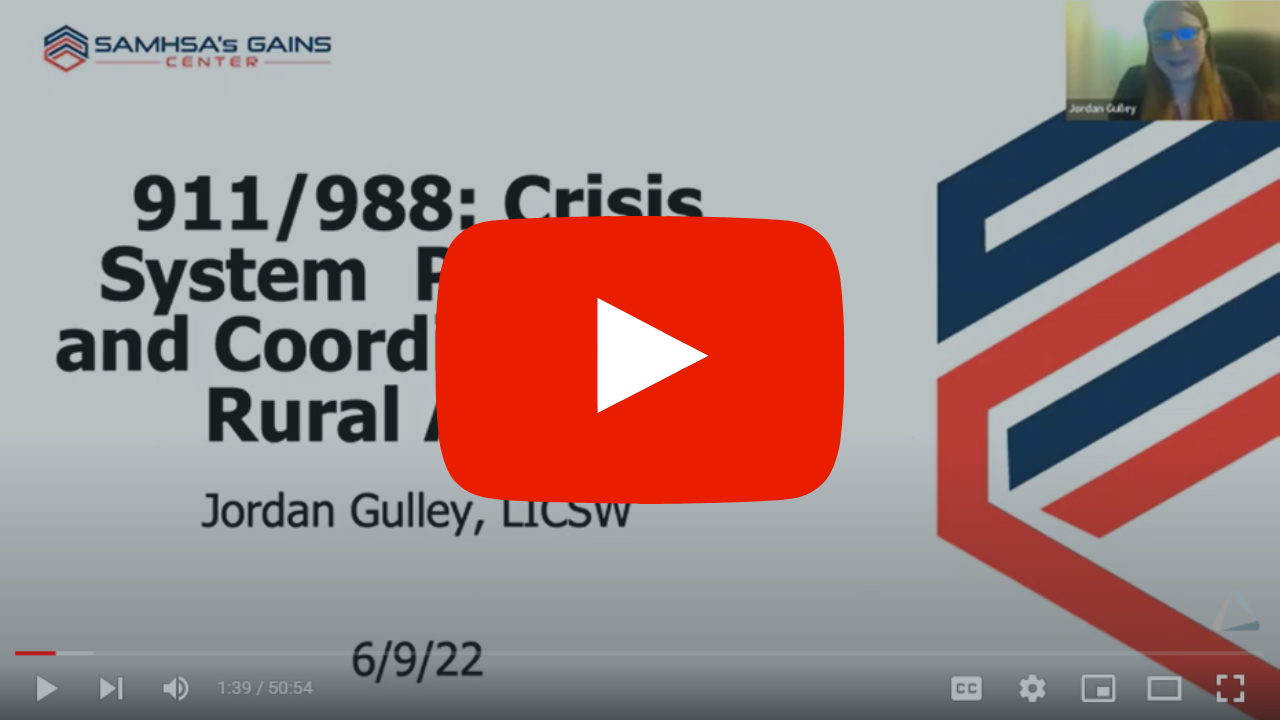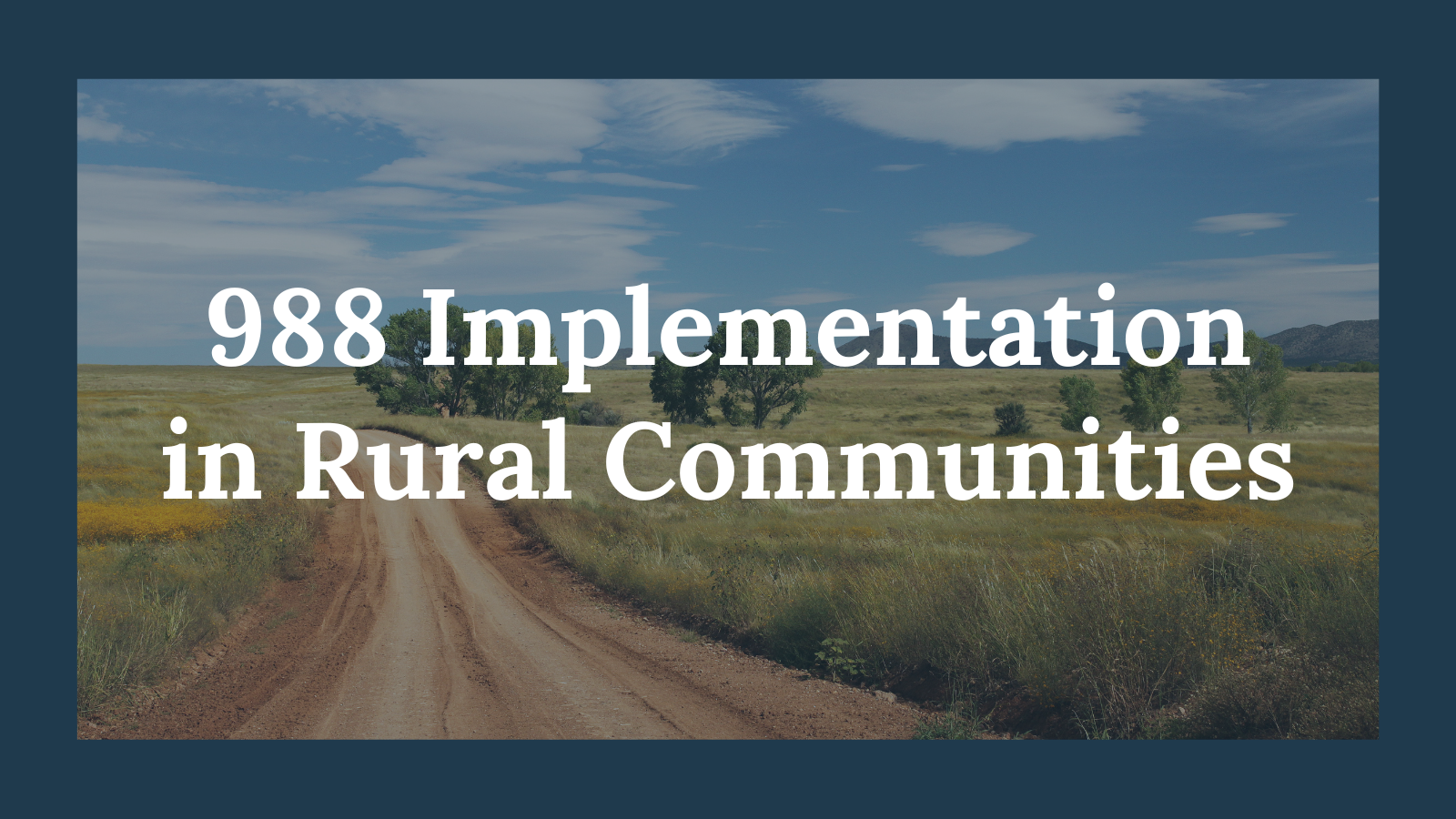Since 2019, the Substance Abuse and Mental Health Services Administration (SAMHSA), along with other federal, state, and local partners, have worked to centralize and standardize the crisis call system. This work is one part of SAMHSA’s overarching goal to transform the nation’s behavioral health crisis care system, so that services are available to “anyone, anywhere, anytime.” In 2022, the three-digit 988 Suicide and Crisis Lifeline was launched. Consolidating and expanding upon the Suicide Lifeline and the Veterans Crisis line, 988 is intended to function much like 911 in that any person anywhere in the country can dial or text those three digits and be connected to a trained professional to help them address a suicidal, mental health, and/or substance use crisis. Beyond simply finding a trained resource at the other end of the phone line, the ultimate goal is for 988 to become part of a comprehensive crisis care network that includes mobile crisis team response and linkage to crisis stabilization units.
988 in Its First Year
In many areas across the United States, the initial roll-out of 988 provided a centralized entry point for anyone in mental health or substance use crisis to call and be connected to a trained counselor. Since the launch of 988 in July 2022, states and local partners have set up more than 200 independent crisis centers nationwide with trained staff available to answer 988 calls. The Lifeline has consistently demonstrated high usage rates: In May 2023, 469,023 calls, texts, and chats from across the nation were routed to 988. Ninety-three percent of all contacts were answered, with an average wait time of 35 seconds. This is a substantial improvement over the average of two minutes and 20 seconds in May 2022.[1]
The National Suicide Hotline Designation Act of 2020 required the Federal Communications Commission to designate 988 as a universal suicide and mental health crisis hotline and required all U.S. telecommunications carriers to activate 988 for phone and text by July 16, 2022. As part of 988 implementation, some states have introduced or passed legislation to formalize funding and strengthen crisis response systems in their states. As of November 2022, at least 24 states had passed legislation to study or finance 988 initiatives.[2]
988 in Rural America
An important feature of 988 is that it is available to everyone in the United States, regardless of location. This is vitally important in rural parts of the country, as research shows that suicide rates are higher in rural areas (about 19 suicides per 100,000 people annually) than in urban ones (about 13 per 100,000 people).[3] Between 2000-2020, suicide rates increased 46 percent in non-metro (i.e., rural or suburban) areas compared to 27 percent in metro areas.[4] This risk is particularly high among Veterans, American Indian/Alaska Native populations, farmers, and LGBTQ+ individuals.

This recording is part of SAMHSA’s GAINS Center’s 988/911 Policy Academy “Ask the Expert” Series. It was recorded on June 9, 2022.
Addressing and preventing suicide and other mental health and substance use crises in rural areas can be particularly difficult. Challenges include communities being spread across vast geographic areas with limited services (e.g., behavioral health, transportation), the low numbers of trained providers, the scarcity of emergency services (emergency departments, crisis centers, etc.), and ongoing stigma regarding mental health and substance use issues.
Spotlight on 988 in Rural Alabama and Mississippi
988 implementation, buoyed by increased funding and supportive legislation from states, is helping some rural areas address suicide crises head on. In Alabama, where 55 out of 67 counties are considered rural and more than 43 percent of the population lives in a rural community,[5] 988 implementation presents an opportunity to redesign the crisis care system to meet the needs of rural residents. “We now have three crisis centers positioned in four regions [soon to be five] throughout the state responding to all 988 calls. By the end of 2023, we anticipate an additional three more crisis centers to apply for 988 call center designation,” says Beverly Johnson, MPA, director of prevention for the Alabama Department of Mental Health. “These centers look very different based on geography, access, and need—each center is set up with culturally relevant services, such as those for deaf and hard of hearing populations, and the ability to meet the needs of the unserved and underserved.” Johnson and her team are working toward a “crisis now” model where every person, including those in rural communities, has someone to call, someone to respond, and a safe place to go. That is being accomplished through the work of 16 mobile crisis teams (13 adult and 3 adolescent) that are now able to respond to any 988 call anywhere in the state. This program is funded through a variety of means, including American Rescue Plan Act (ARPA) funds, SAMHSA block grants, and state appropriations.[6]
Similar strategies have been employed in Mississippi, another predominantly rural state where more than half (54 percent) of the population lives in a rural area.[7] Mississippi has crisis stabilization units throughout the state, and mobile crisis response teams have also been in place statewide since 2014, but since the COVID-19 pandemic, these teams often struggled with adequate staffing to respond to the need. The implementation of 988, along with SAMHSA grant[8] funding and related legislation, has allowed the state to dramatically increase their ability to respond to crises statewide. “Our call centers now have some of the highest response rates in the nation,” says Brenda Patterson, director of the CONTACT Crisis Line, one of the state’s two call centers for 988.
Like Alabama, Mississippi has mobile crisis team coverage for every area of the state. “Our state is largely rural,” says Katie Storr, chief of staff with the Mississippi Department of Mental Health, “but our mobile crisis teams can get to anyone in crisis within 2 hours. We have 12 different community mental health centers statewide coordinating all together for 988.” For efficiency, the community mental health centers run both the mobile crisis teams and the crisis stabilization units that respond to 988 calls.
An ongoing challenge in managing crisis in rural areas is the limited availability of higher levels of care, such as crisis stabilization units or emergency departments with the capacity to serve a person in mental health crisis. This national shortage of emergency medical services in rural areas[9] requires rural residents to travel greater distances to get needed care. Along with the implementation of 988, recent legislation in Mississippi aims to improve the connection to crisis response and care. The legislation mandates that all police departments have a Crisis Intervention Team officer on staff to respond to crisis situations and have a mechanism to provide transportation to any person in crisis to an appropriate level of care, but implementation of that mandate poses challenges. “Transportation is an issue,” says Patterson. “Who is going to take a person in crisis to a higher level of care? How do we manage the warm handoff? And, with our shortage of beds, where will they go? We are still working that out.”
Resources to Learn More
Communities interested in learning more about implementing or improving 988 in rural areas have a number of resources available to them. The Federal Office of Rural Health Policy is supported by the Health Resources and Services Administration of the U.S. Department of Health and Human Services, and it contains a myriad of resources for those working or interested in rural healthcare. The Suicide Prevention Resource Center at the University of Oklahoma (and funded through a SAMHSA grant) offers resources for rural providers to address suicide and suicide risk. Finally, visit the 988 Suicide and Crisis Lifeline website to learn more about 988.
Footnotes
[1] “988 Lifeline Performance Metrics,” SAMHSA, last updated April 24, 2023, https://www.samhsa.gov/find-help/988/performance-metrics
[2] National Association of State Mental Health Program Directors, State-by-State Legislative Analysis of Funding for 988 Suicide And Crisis Lifeline (December 2022), https://www.nasmhpd.org/sites/default/files/2022-12/nasmhpd2205_988State-StateLeg_Dec2022_121522_508.pdf
[3] Rural Health Information Hub, Rural Suicide Prevention Toolkit (2022), https://www.ruralhealthinfo.org/toolkits/suicide
[4] “Suicide in Rural America,” Center for Surveillance, Epidemiology, and Laboratory Services, Centers for Disease Control and Prevention, last updated April 21, 2023, https://www.cdc.gov/ruralhealth/Suicide.html
[5] “At a Glance,” Office of Primary Care and Rural Health, Alabama Department of Public Health, last updated May 13, 2021 https://bit.ly/3H2D5zz
[6] “Rural Crisis Care and Mobile Crisis Teams,” Alabama Department of Mental Health, accessed May 31, 2023, https://mh.alabama.gov/rural-crisis-care-programs/
[7] “Rural Health,” Food and Health, Mississippi State University, accessed May 31, 2023, https://bit.ly/3LfFQ30
[8] Garrett Lee Smith Suicide Prevention grants are funded by SAMHSA to support suicide prevention work in campus, state, and tribal communities.
[9] See for example, Elizabeth A. Dobis and Jessica E. Todd, “The Most Rural Counties Have the Fewest Health Care Services Available,” U.S. Department of Agriculture Economic Research Service, last updated August 1, 2022, https://www.ers.usda.gov/amber-waves/2022/august/the-most-rural-counties-have-the-fewest-health-care-services-available/
Like what you’ve read? Sign up to receive the monthly GAINS eNews!


